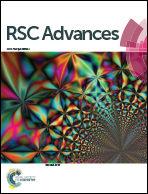Effect of different-sizes of hydroxyapatite on the water resistance of magnesium oxychloride cement for bone repair
Abstract
Magnesium oxychloride cement (MOC) has recently attracted significant attention due to its excellent mechanical properties and biological behavior. However, the applications of MOC have been limited by its poor water resistance. To solve this problem, micro-sized hydroxyapatite (μ-HA) and nano-sized hydroxyapatite (n-HA) were used to improve the water resistance of MOC. The microstructure, mechanical strength and tissue responses of three types of MOC were investigated. The results demonstrated that the lost strength of MOC-0, MOC/μ-HA and MOC/n-HA were 0.92 ± 0.04, 0.81 ± 0.02 and 0.55 ± 0.01 after immersing in SBF for 28 days. The contact angles of MOC-0, MOC/μ-HA and MOC/n-HA were 42.5 ± 4.76°, 50.3 ± 5.63° and 70.4 ± 6.59°, respectively. Compared to MOC-0 and MOC/μ-HA, the filling role of the n-HA in the cement was more favorable for the formation of 5 Mg(OH)2·MgCl2·8H2O (phase 5) and a dense microstructure. In addition, the histological evaluation displayed that MOC/n-HA enhanced the efficiency of new bone formation. It also showed good biocompatibility and biodegradability in vivo. And MOC/n-HA had better osteogenic performance. Therefore, MOC/n-HA could be used as a potential bone void filler for irregular bone defects in clinical applications.



 Please wait while we load your content...
Please wait while we load your content...